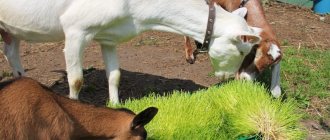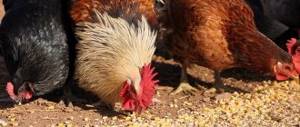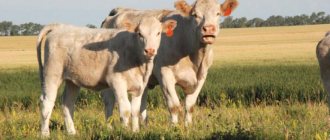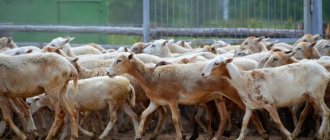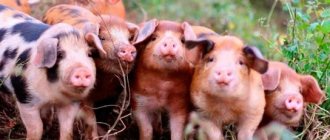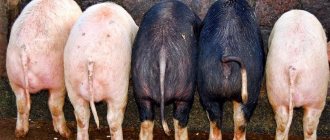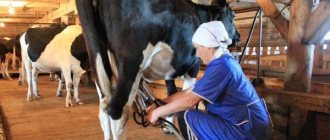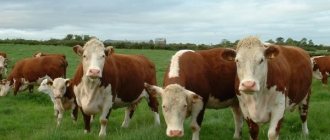Types and composition of feed for cattle
Cattle productivity primarily depends on the quality of feed. The climate in Russia does not allow cows to be grazed year-round. The inclusion of mixed feed in the diet of cattle makes it possible to enrich it with all the necessary components for normal animal growth and high milk yields. Complete formulations contain a balanced complex of nutrients, vitamins, minerals and enzymes, selected taking into account age and breed. Unlike grain mixtures for cattle, they do not need to be combined with other ingredients. All components of the feed are combined in such a way as to increase the digestibility of the product. The requirements for its composition and quality are regulated by GOST R 52254-2004 and GOST 9268-2015.
Concentrated feed for goats
Concentrates in a goat's diet are not the main component of the diet - they are added to maintain normal nutrient levels. The specific share of grains in their diet is only about 30%. If it is significantly impaired, there is a risk of damage to the gastric system of animals. In addition, goats are easily at risk of becoming obese.
Goat
Basically, the following types of products are added to horned animals:
- barley;
- meal;
- oats;
- corn;
- cake;
- bran.
Dairy goats are also given hay made from alfalfa and other legumes to increase productivity. (photo 18 - feeders in the stall).
As with pigs, goats are given concentrates mixed into combination mixtures—they are not attracted to dry grain as much as wet mash. Sample recipe:
- oat flakes – 25%;
- ground wheat – 9%;
- wheat bran – 22%;
- sunflower meal – 10%;
- nutritional yeast – 5%;
- salt – 1%;
- premix – 3%.
Mix all the ingredients thoroughly and pour boiling water over them, letting the mixture steep for up to half a day before dispensing the food.
What to feed goats?
Find out everything about feeding goats at home in a special article on our portal. What are the main food groups in the goat diet? What is the correct feeding regime and routine for goats? What to feed a goat before and after lambing? What should you not feed goats?
Advantages of feed for cattle
- Their use allows increasing animal productivity by 10-12%. Individuals receiving mixed feed grow better, get sick less, and produce more milk. In addition, their reproduction rates increase and their productive period increases.
- Ready-made feed contains nutrients in the form most convenient for absorption. Accordingly, cows receive more useful elements from the same amount of food.
- Feed recipes are developed for a specific age and breed and stimulate the improvement of the indicators required by the breeder.
- The use of ready-made mixtures makes it possible to reduce product consumption. Animals are satisfied with less food, and thanks to the inclusion of additives in its composition to improve appetite, they eat it almost completely. As a result, the amount of waste is reduced.
- Enzymes and minerals that support the optimal functioning of cattle, such as salt, are added to the feed.
- Dry mixtures are easy to transport and designed for long-term storage. They do not lose their nutritional value and are not affected by mycotoxins and harmful microorganisms.
- Combined feeds are easy to dose. Residues are easily removed from the trays, making it easier to maintain hygiene in the barn.
Concentrated feed for sheep
The digestive system of sheep has a structure similar to that of goats. Therefore, frequent use of concentrates in this case is also not recommended in order to avoid the manifestation of stomach diseases. The optimal rate of feed distribution is up to 200 grams per female per day and up to 700 grams per breeding male.
Sheep nutrition
To balance carbohydrates, protein, and fiber, mix the following types of grains:
- corn;
- legumes;
- cake
Sheep give particular preference to corn concentrates.
Corn
Use the following recipe containing this product:
- oats – 25%;
- wheat – 5%;
- barley – 25%;
- wheat bran – 21%;
- sunflower meal – 12.5%;
- yeast – 7.5%;
- salt – 1%;
- premix – 1%;
- defluorinated phosphate - 2%.
Prices for felucene mineral lick for goats
Felucene mineral lick
Recipe components can be replaced with others of equal composition.
What to feed the sheep?
Find out more about the diet of sheep in the household from our article . What does the sheep diet consist of and what food groups does it include? What mineral supplements do sheep need? Feeding rates depending on the season and age of the sheep. Feeding of pregnant and suckling sheep, lambs, breeding rams.
Types of combined feeds
All mixtures can be classified according to several criteria.
| Compound | Complete feeds contain all the necessary nutrients and fully meet the daily calorie requirement. When using them, you can refuse to include other foods in your diet. Concentrated - introduced as a supplement to roughage and succulent feed. Replenish the lack of nutrients, especially in winter. Concentrates can be carbohydrate (up to 70%) and high-protein (up to 25%). In the first case, the composition is dominated by grain crops, in the second - legumes. The total share of concentrates should not exceed 50%. Balancing additives and premixes contain high concentrations of proteins, vitamins, enzymes, micro- and macroelements. BVD and BVMD are introduced into the diet in an amount of 20-30%, premixes - about 1%. Whole milk substitute is a dry mixture based on skim milk, buttermilk and whey, enriched with animal fats, starch, and biologically active substances. It may contain antimicrobial and antidiarrheal components. CCM is used in diluted form for industrial breeding of calves. |
| Release form | Loose feed is a mixture of crushed ingredients that has been dried. Crushed cattle can be fine, medium and coarse. Such feeds are cheaper than their analogues, but they are less hygienic and produce a large amount of dust. To prevent it from entering the respiratory tract of animals, it is necessary to equip the room with reliable ventilation. Granular feed has the form of cylinders or tablets of various sizes: 2.5-20 mm in diameter and 4.7-40 mm in length. They are more convenient to store and serve and are better digestible. During the production process, the ingredients are subjected to short-term high-temperature treatment. As a result, pathogenic microorganisms are destroyed and nutrients are broken down into simpler compounds that are easier to digest. Animals eat the pellets whole, without choosing tasty morsels, and receive the maximum of nutrients. Briquetted compositions are produced in the form of rectangular tiles, which are convenient to dose and crush to the desired size. After drying, the feed components are sent under a press and combined with feed molasses (molasses). |
| Purpose | Depending on the age and direction of the animals, food is distinguished:
During the stall and pasture periods, different modifications of feed for the same purpose are used, differing in the percentage of nutrients. This makes it possible to avoid a shortage of useful elements in winter and their excess in summer and autumn. |
Concentrates in the diet of farm animals
Concentrated nutrition is a homogeneous substance of mixed structure, which consists mainly of legumes, cereals, grains, waste products of plant and animal production, which have previously undergone the stage of purification and grinding.
Cereals are the basis of concentrates
In addition to increasing the overall level of pet productivity, this type of food can regulate the nutrition of your pets in case of a lack of certain nutrients in the diet.
The basis of this group includes the following substances:
- water – 16%;
- fiber – 15%;
- starch;
- protein.
If the starch content is higher than protein (60-70%), the food is classified as carbohydrate. Such a high percentage can be achieved by adding barley, rye, oats, corn, wheat, etc. An increased amount of protein (20-45%) indicates that this is a high-protein substance. You can make it this way using soybeans, beans, peas, meal, cake, etc.
Legume fruits
Proper processing of grain will help protect you from excessive consumption of products during feeding, as well as achieve high productivity. There are several main types of grain processing - the main component of concentrated food.
Feed components for cattle
The types and amounts of ingredients in specific products vary depending on the group of animals they are intended for. However, the basis of all feed mixtures for cattle are components of plant origin:
- Cereals (barley, wheat, corn, millet, triticale). They are a source of carbohydrates and proteins, their percentage can reach up to 85%.
- Legumes (soybeans, chickpeas, peas, lupine) provide the protein needs of animals. In feedstuffs for fattening cattle, their share can be up to 45%.
- Meals and cakes (processed products of sunflower, flax, soybeans, rapeseed) make up for the lack of fat. The amount of components obtained during the production of vegetable oils is from 15 to 25%.
- Grass meal and bran are a source of fiber necessary for normal digestion in ruminants. As an alternative, feed grains are used. The proportion of fiber should be at least 20-25%.
To replenish the cattle's need for vitamins, minerals and animal protein, yeast, feed phosphates, highly purified salt, meat and bone meal, blood meal or fish meal are added to the feed.
Complexes of biologically active substances include in various proportions:
- vitamins A, E, D;
- macro- (calcium, phosphorus, sodium, magnesium);
- and trace elements (iron, manganese, copper, iodine, sulfur, zinc, cobalt).
The possibility of long-term storage of the product is achieved by adding components that prevent caking and the development of harmful microorganisms.
Features of feed for calves
Up to 6 months of age. Animals have an increased need for carbohydrates, so their amount in starter compositions is close to 70%. A growing body requires a lot of energy, which it receives mainly from grain crops (barley, feed wheat, oats) and wheat bran. Calves need less protein than adults, but much more crude fiber.
Since the digestive system at this age is not yet sufficiently developed, enzymes are added to the mixture to improve its digestibility. Normally, the metabolic energy of feed for calves should be at least 11 MJ. Nutritional indicators are:
- crude protein 20%,
- calcium 0.9%,
- phosphorus 0.8%,
- sodium 0.4%,
- crude fat 3.5%.
In young animals aged 6-12 months. the need for proteins increases, and he needs 2.5 times more fiber than adult animals. For healthy bone growth, calves require vitamin D, and for normal metabolism, the essential amino acids lysine and methionine. Sunflower meal and grass meal are introduced in significant quantities into the diet of young animals, starting from six months of age. In the grazing period, feed wheat or corn predominates in the feed; in the stable period, barley predominates.
Compound feed for cows of different breeds and bulls
The nutrient content in formulations for adult animals depends on which product they belong to: dairy or meat. Compound feed for dairy cows contains a lot of proteins, crude fat, iron, and starch. However, they are relatively low in fiber. During the calving and milking period, mixtures are used that stimulate milk production and increase the concentration of protein and fat in it.
At the 2nd stage of lactation, feed is used to replenish the loss of proteins, calcium, and phosphorus. This makes it possible to prevent the exhaustion of cows and extend their productive period. The quantity of milk, its taste and nutritional value directly depend on the quality of nutritional mixtures.
Compound feed for beef cattle is characterized by a high protein content. Increased protein intake promotes rapid muscle gain. The mixtures contain a lot of barley, oats, and soybean meal.
Compound feeds for breeding bulls are rich in easily digestible carbohydrates, which have a positive effect on the activity of animals. For normal spermatogenesis, their diet must include in sufficient quantities:
- phosphorus,
- calcium,
- zinc.
Due to the accelerated metabolism, breeding bulls require feed with increased nutritional value (by 20-30%). They contain many legumes and cereals, as well as cakes and flour of animal origin.
Types of concentrated feed processing
Grinding
Allows you to adapt grains to feed different types of farm animals. You can achieve the desired result in the following ways:
- grinding;
- splitting up;
- flattening.
The crushed product is easy to mix with other types of food: silage, root crops, straw of various sizes.
Milled wheat
The advantage of this processing method is that the grinding process releases starch in the grains. It gives a certain sweetish taste. At the same time, the protein in the feed becomes less digestible. The availability of amino acids also decreases. The problem can be solved by increasing the output of the crushed substance to 20-30 percent of the daily requirement or by mixing with other products containing protein.
Prices for grain grinder
Chopper for crushing all types of feed grains and seeds
Malting
Refrigeration is necessary to improve the taste of food - due to the destruction of starch formations, sugar is released. Such substances are often used to feed young animals (artiodactyls and equids).
Grain for malting
In adults, malted cereals help maintain appetite at the proper level.
Yeasting
The process involves saturating foods with the missing amount of yeast and bacteria of lactic acid origin, and B vitamins. In this way, you can significantly increase the amount of protein in the diet of your charges.
Yeast for this process under a microscope
It is believed that when using grains that have undergone the yeast process, the total amount of materials used is saved by 20-25%. At the same time, the overall productivity of your pets increases by an average of 15%.
Extrusion
The mechanical process of processing grain by adding it to a special device - a press extruder.
Press extruder
Inside this device, substances are subjected to strong pressure, grinding, compression, during which the quality of the protein significantly improves, the percentage of sugar increases, and starch is converted into useful dextrin.
DIY feed granulator
A feed granulator allows you to produce granulated feed in your household, which is not inferior in quality to purchased feed. There are many advantages to feeding pellets to animals, one of them being control over the balance of the diet. Read our article to find out how to make such a useful tool with your own hands.
Feed granulator prices
Feed granulator
Thanks to the baked aroma, the resulting grain is much better perceived and digested by animals.
Micronization
The method is based on the use of infrared radiation technologies. Under the influence of rays, the seed becomes very hot, after which it must be flattened and gradually cooled, otherwise the acquired properties will be lost.
Micronized seeds
In addition to the massive breakdown of starch, micronization makes it possible to achieve an increase in the number of alkali-soluble proteins - thanks to them, animals better assimilate the resulting food.
Concentrated horse feed
Of all the concentrates, horses love oats most of all in its form - grain, hay, meal or cake. Although other cereals (barley, wheat) are also welcome.
Horse eats oats
Oats can be given to animals on their own, but other types of concentrated feed must be mixed into the combined food. At the same time, grains are given to horses depending on the degree of their physical activity and lifestyle:
- oats are needed to maintain and produce energy throughout the day;
- barley and rye are a good nutritional addition to other foods;
- wheat is added to the diet if rapid weight gain is necessary.

